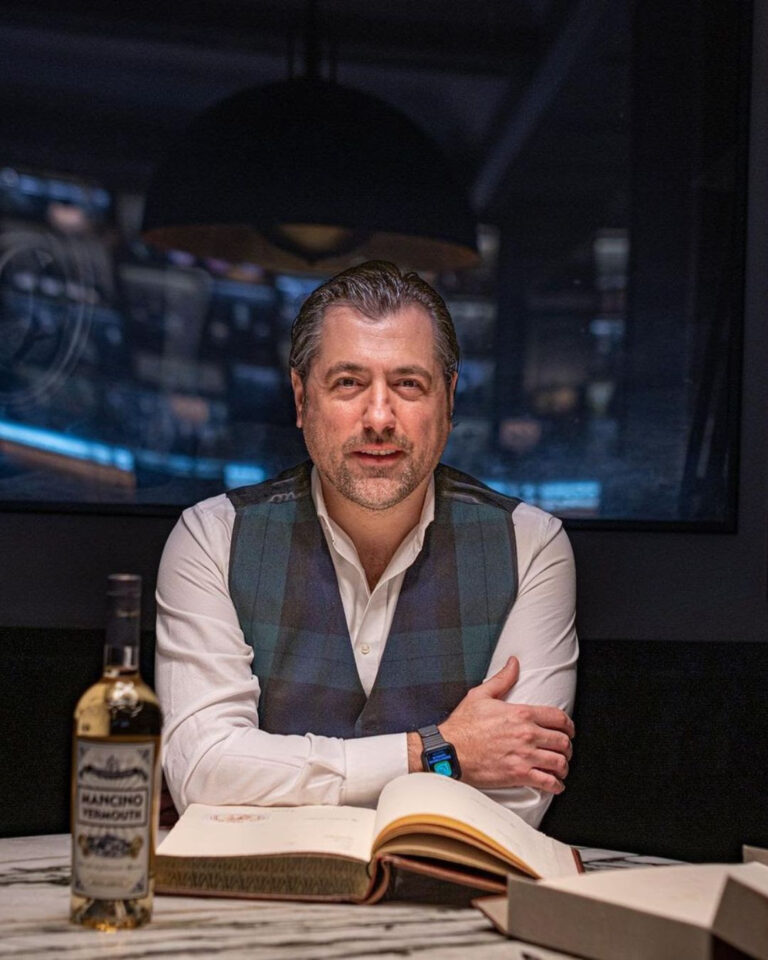This story originally appeared on the Gents Cafe Newsletter. You can subscribe here.
Giancarlo, you’re a bartender and an entrepreneur: you’ve founded several businesses and brands. I’d like to know a little about your background and what brought you to the world of drinks and cocktails.
I was born in Pignola, in Southern Italy, and I left Italy when I was twenty to then live in several parts of the world. I was just a barman then, and I worked in America, in Great Britain, and especially in Asia, where I stayed for about half of my career. Back then my area of expertise was consulting, both for luxury hotels and high-end restaurants – something I still do today with my company Giancarlo Bar Limited – but I saw the opportunity to become an “entrepreneur”. I realized that, while the bartending world was moving forward in terms of quality, culture, and innovation of drinks, the basics were often lacking: basics like glassware, strainers, even base spirits…
Mixology was getting better and better, but everything around the traditional figure of the barman was left behind. Mixology, meaning the art of combining spirits in new and unexpected ways, is certainly important; but I come from a different universe, that of traditional Italian bartending, where elegance, class, and the barman’s savoir-faire are the key. At that moment I knew there was a great opportunity to bring Italian style to the world. That’s indeed why I decided to start my own brand with Vermouth, which is a typically Italian product and also one of the key ingredients of most cocktails. It wasn’t about reinventing it, it was a matter of understanding how it’s done and then trying to make it better, imbuing it with more contemporary flavours, fit for the modern taste. After spending some time in Piemonte, learning the traditional way of making Vermouth, and getting to know its basic botanicals, I remastered some traditional recipes, bringing them closer to my own palate, and I started marketing it under my family name Mancino. Over the first six months, we sold five thousand bottles in Hong Kong alone: at that point, I knew the business was up and running.
Of course, I’ve been lucky to seize the right moment: it was eleven years ago, and craft spirits were really getting in the spotlight all over the world. Shortly after we launched Mancino Vermouth, chef Umberto Bombana got his third Michelin Star in his Hong Kong restaurant – and that happened after we provided a consulting for the restaurant’s bar, and I started preparing Sgroppino right at the table. Almost all the credit goes to him, of course, but the third star probably came because the bar of the restaurant started working very well. This lets you understand the relevance of good bartending in the world of food.
After that, Mancino Vermouth established a collaboration with glassware brand Italesse, launching the Wormwood line of glasses, decorated with Artemisia leaves, the base botanical for Vermouth. We also worked with British brand Urban Bar, making crystal glasses and shakers and silver strainers, part of a line called “Classico da Giancarlo Mancino”: all these products were meant to be a return to the origins of bartending and to my personal origins too. And we’re also developing spirits, like Rinomato, a new brand of ready-to-drink aperitivi, and a rum we’re making with Davide Cordoba, a former Bacardi employee, that we called The Lover Rum & La Forza.
So Mancino Vermouth is what really got me into the entrepreneurial world, but in my marketing strategy, I know it’s also important to keep doing consulting, which is also a way to do effective product placement.
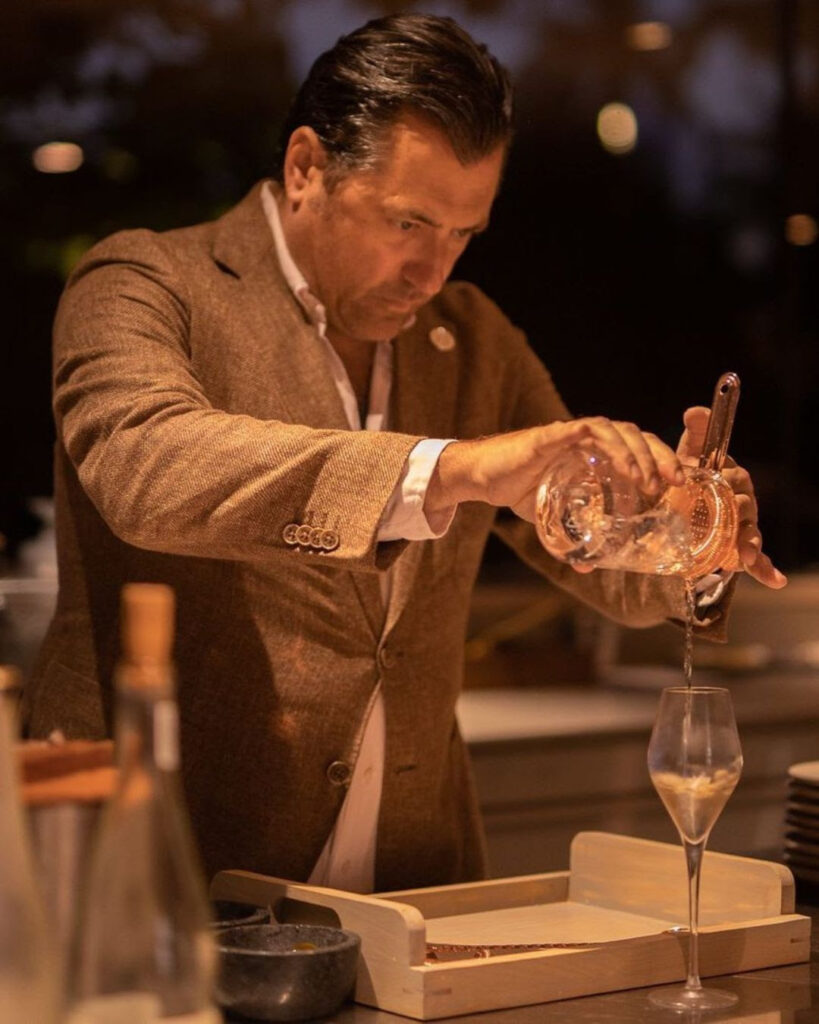
Another thing I wanted to ask is indeed about this duality between being a barman/entrepreneur and a consultant: it certainly has its perks, but isn’t maybe also difficult at times?
Actually, that’s all a matter of experience and passion: I started behind a counter, and being there, talking with clients, explaining to them what they are drinking is what keeps me going. I’m often traveling around the world, bartending or giving speeches, and I feel that people really need to be “educated” about drinking. As an example, later this summer I’ll be at the Lisbon Bar Show, where I’ve been asked to hold a panel about the Italian aperitivo. Nowadays people read aperitivo everywhere: it’s on beverages, at bars and restaurants, on lists… it’s confusing at times, and people need to be educated about what aperitivo really means: what traditional aperitivi are, how they’re mixed, when they should be ordered… that education is the barman’s responsibility, and I love being able to do that. Then, if my products get in play, of course, it’s all for the best.
Could you sum up two or three skills that have been fundamental in shaping what you do today?
First of all, I consider myself a great Italian barman. I don’t mean that I am personally great, it’s more about belonging to a category of people who have a certain elegance and hospitality, professionals who can get behind a counter and mix you a top-notch Classic. Then, of course, they can have a whole mixology laboratory behind the wall, and experiment with unexpected mixtures and flavours, but mastering the Classics is a must. You must also know how to talk and chat with clients, and how to make them feel at ease. I grew up as an apprentice of Salvatore Calabrese, and I realized when I was still very young that people would come to the bar for Salvatore first and foremost, and the cocktails were almost secondary. These days there are lots of cool places, with the right mood, a nice atmosphere, and interior design on point, but how many are the bars that get you there for their barman? Very very few. I think these are the fundamental skills, which could be summed up in “being a barman” – an Italian barman, if you want.
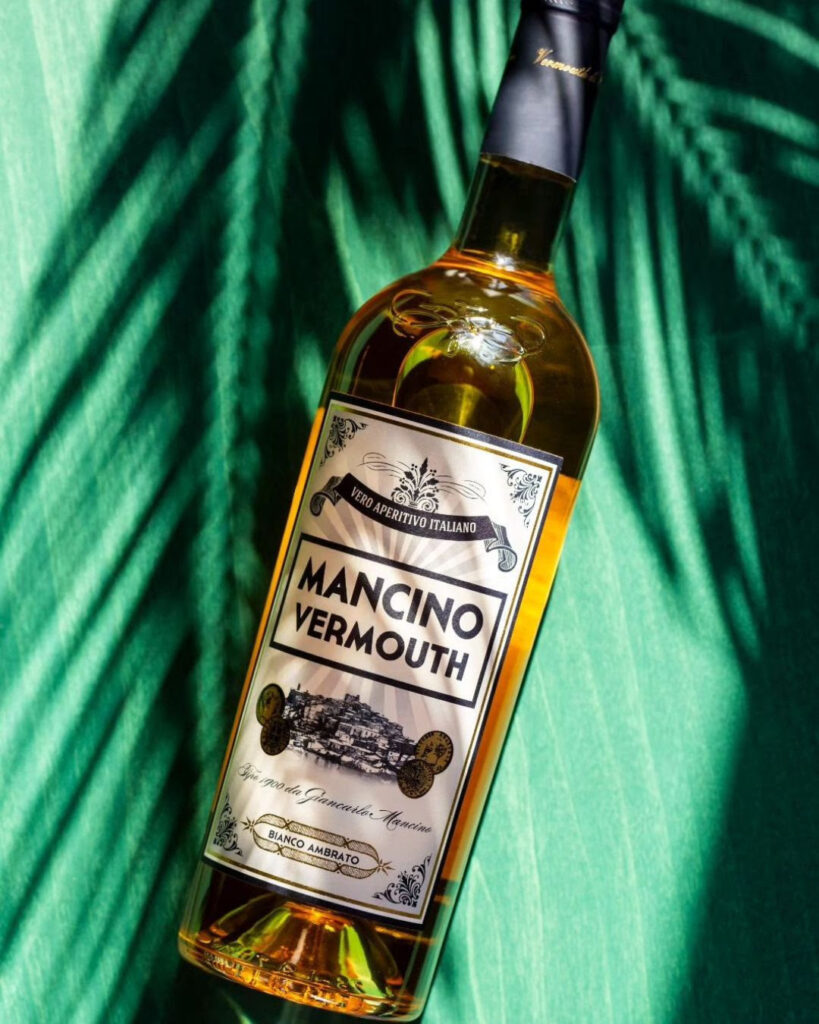
Speaking about your own Vermouth, Mancino, how would you present it? What would you say are the traits that set it apart from other Vermouths?
What I treasure most is the transparency about the spirit. When I first went to Piemonte, I saw not everyone was crystal clear on many labels: in order to be called a Vermouth, the liquid should be made starting from at least 75% of Italian wine, but that’s not always stated on the bottles: on our bottles, it is. Likewise, we treat all other ingredients just as seriously: Artemisia must come from Piemonte, and that’s what we do, using three different species. And all other components are sourced in Italy as well. Then, a peculiar note of Mancino Vermouth is the palate: that’s personal, of course, but I resorted to my experience as a barman to develop what I believe is the ideal blend to mix great classics. The Mancino Rosso has a flavour that balances really well with gin, the Mancino Secco has been refinished to be a perfect Martini base, and so on.
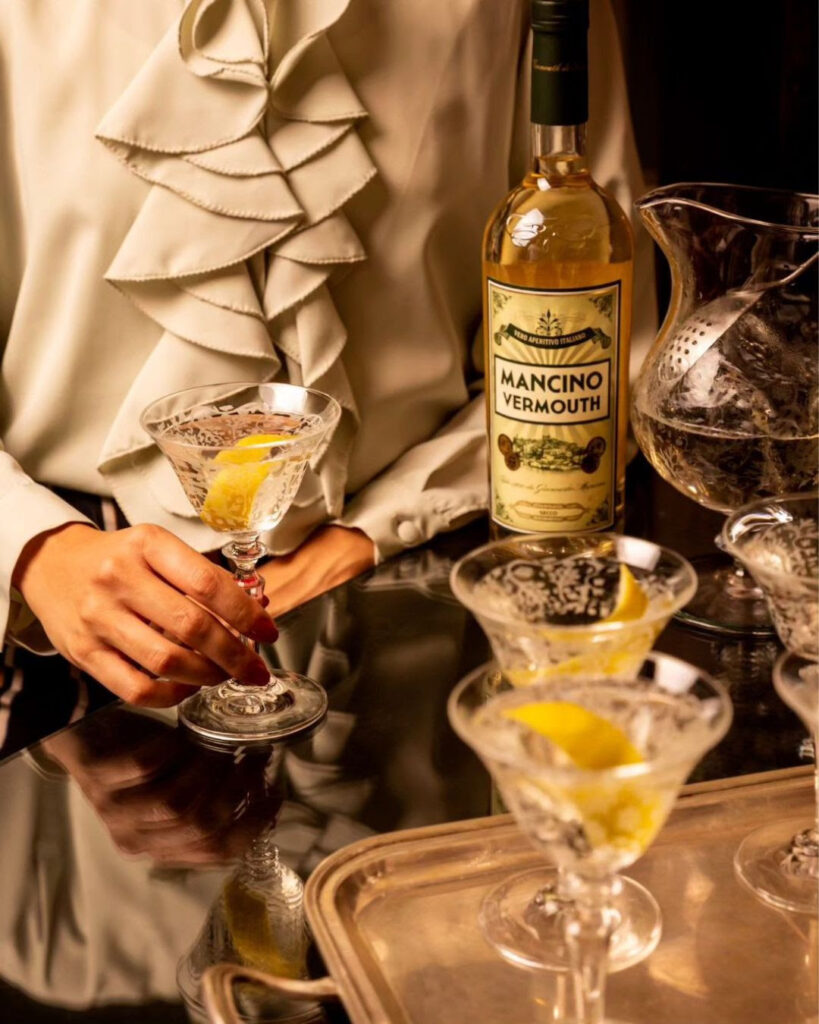
Do you have a go-to recipe? Something you’d mix for yourself on a Friday evening?
Of course! It’s Martini, and it all starts from the glass: it has to be small, and that’s why I designed my own glass, the Wormwood Astorea. Then, my ideal proportions are 25ml of Mancino Secco and 45/50ml of Gin. I like to garnish it both with a lemon twist and an olive. Or, if it’s a Gibson Martini, I opt for a pickled onion. Once again, what really matters, is the quality of the ingredients: the Martini is a very essential recipe, so it’s crucial that both the spirits and the garnish are the best available. If the lemon is not fresh, or the onions are too sour, the outcome will have flaws: it’s an error that even some experienced bartenders make because all they care about is the gin.
Talking about cocktails, what would you say are the best Mancino-based ones?
Since Mancino Vermouths were conceived with two specific cocktails in mind, I would definitely say Negroni with the Rosso and Martini with the Secco. The Bianco is the ideal ingredient for a Vesper, because it’s strong on Kina, and our vintage blend, the Vecchio, is perfect for a Manhattan. Then we’ve got the Sakura, the Kopi and the Clay Pot which are less traditional in taste and structure and have been heavily influenced by the years I spent working and traveling in Asia. The Sakura brings an interesting twist to a Gibson Martini, but is also a strong base for a Key Royale, while the Kopi and the Clay Pot are also Negroni-oriented vermouths. Anyway, we suggest several different recipes on our website, and we’re also offering a free-download booklet with some of our favorite cocktail inspirations.
Vermouth is definitely your most important product: what do you think has been the reason behind its rediscovery, and where do you see it going in the near future?
I think it was just a matter of time until someone started producing some well-crafted Vermouth, and I’m both proud and lucky to have been amongst the first. I say so because Vermouth is such a versatile spirit: most cocktails, from any part of the world, need it. On the one hand, our work with Vermouth let us discover some interesting and almost forgotten facts: for example, the go-to drink in 1940s Peru was a mix of Pisco and Red Vermouth. So it’s not limited to the IBA classics: you can also use it for a spritz, or even for a “V&T”, a Vermouth and Tonic. I think the world of Vermouth will continue growing for ten more years at least: many new brands are just getting started, and some established winemakers are launching their own Vermouths too.

Let’s talk of your other products, like your ready-to-drink line…
We have some Vermouth-based RTDs, mixed and bottled in Seattle, which we called Sprezza. We also developed the Americano Bianco and the Aperitivo Deciso, both conceived for the US market. For the Deciso, my goal was to obtain a taste close to the San Pellegrino bitters I drank as a young boy in Italy while keeping it 100% natural, with no chemical ingredients or colorants. Then we’re about to close another big project, called “Sei Bellissimi” [a pun mixing Italian for “You’re beautiful” and “Six great ones”], which are six sparkling cocktails that draw from the Italian tradition. They are all Prosecco-based, and come pre-mixed with fruit juices as they were once done at roadside bars and kiosks. There’s the Bellini, with peach, and the Tintoretto, which was created in Rome way earlier than the Bellini and has pomegranate in it; then we have the Rossini, with strawberry juice, the Puccini, with tangerine, the Mimosa, with orange, and the Raspini, which I originally invented back in England and mixes Prosecco to raspberry juice. Maybe we’ll have a seventh one, released as a limited edition for the Italian distribution, and will be fox-grape based. These “Sei Bellissimi” also come in alcohol-free versions, and are already part of the menus on Singapore Airlines, Saudia, and Icelander.
Let’s leave drinks aside and focus on yourself: where do you see Giancarlo Mancino in the next years? And what tip would you give to fine drinking enthusiasts?
Let’s start with the tip: as I said before, find a barman you can trust. Choose a place where you don’t just drink, but you learn how to drink. And never overlook the classics: they are classics for a reason.
Talking about me, I’m almost 46: I always say to myself that I should slow down by 50, and maybe write a book or something. I’m still not sure about the title, but I would really like to put my entire career in it, from the first time I walked behind a counter to where I am now. This is something my wife cares a lot about, maybe even more than I do. But after all, I think I’ll keep on doing what I’ve always done: bartending, consulting, and traveling. Working in the beverage world really keeps me fueled, and I don’t see myself stepping out any time soon.
You can follow Giancarlo on his Instagram profile @giancarlo.mancino. He’s also running @themartinicocktail and @vermouth_day, two accounts dedicated to his favourite cocktail and to a yearly celebration of Vermouth, occurring every March 21st (coincidentally, it’s also the birthday of his mother Fiorina).

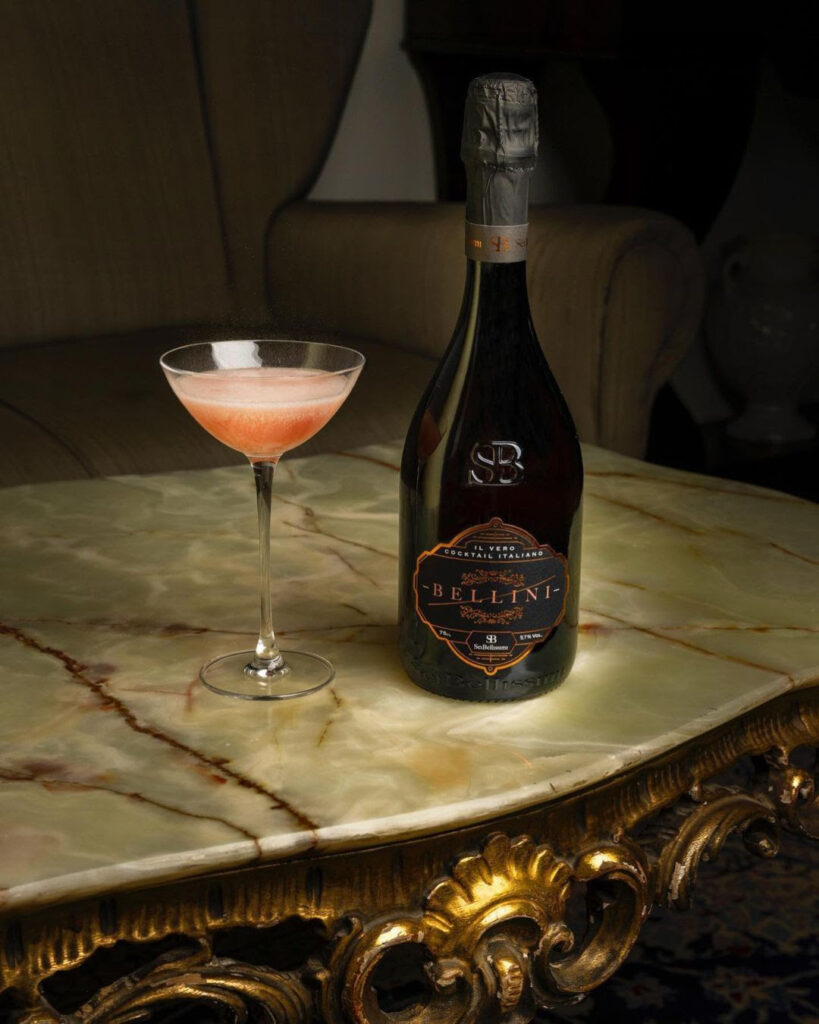
Never miss a story – subscribe now to the Gents Cafe Newsletter, a bite-sized read about men’s lifestyle to enjoy over a coffee or a nice cocktail.

